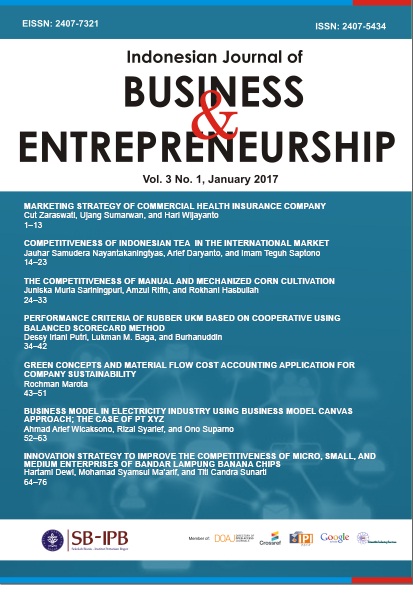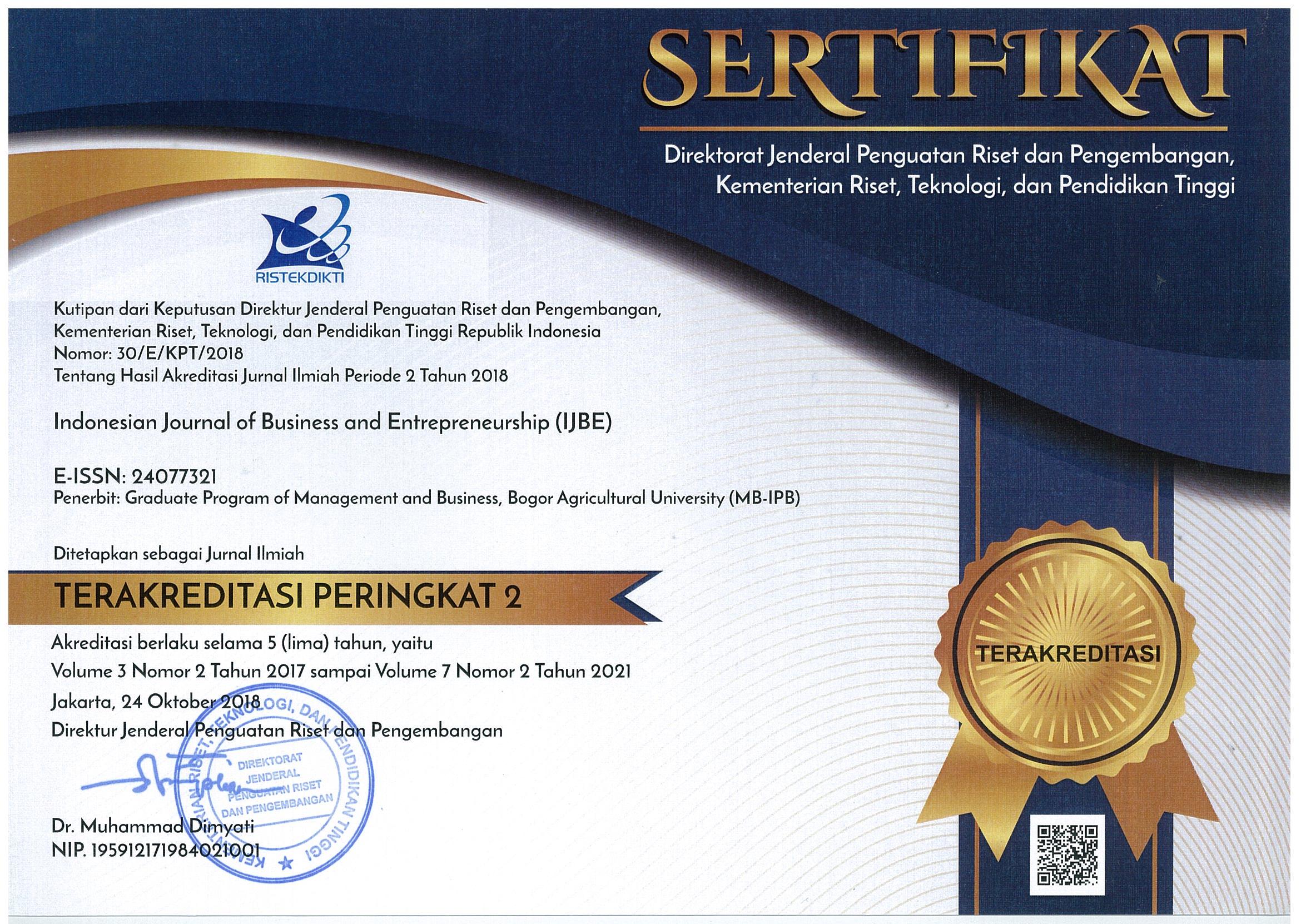THE COMPETITIVENESS OF MANUAL AND MECHANIZED CORN CULTIVATION
Abstract
In 2015, total imports of corn in Indonesia reached 3.1 million tons due to lower corn production of Indonesia. One way to overcome this is to apply the technology mechanization in the cultivation process as practiced by the country largest corn producer in the world. The purpose of this study is to know the level of competitiveness of mechanized corn cultivation and manual. In addition, it is to determine the effect of government policy on competitiveness of both type of corn cultivation. The analytical method used is the Policy Analysis Matrix (PAM). The analysis showed that mechanized corn cultivation is competitive so that the business is feasible to be developed. It is seen from the DRC and PCR- corn agribusiness based on mechanization level values that less than one is 0.54 and 0.50. The manual corn cultivation, however, only show a competitive advantage but does not have a comparative advantage. Output policy is a policy that better influence both type mechanized and manual corn cultivation.Keywords: competitiveness, corn, Policy Analysis Matrix (PAM)
Downloads
References
Abdulquadri AF, Mohammed BT. 2012. The role of agricultural cooperatives in agricultural mechanization in Nigeria. Journal of Agricultural Science 8(5):537–539.
Adamade, Jackson. 2014. Agricultural mechanization: a strategy for food sufficiency. Journal of Agriculture Science 4(3):152–156.
Adekola KA, Akinyemi TA. 2014. Agricultural production and development in Northeast Jilin Province of China. Journal of Advances in Agricultural Science and Technology 2(9):1–6.
Adekola KA, Alabadan BA, Akinyemi TA. 2014. China Agricultural mechanization development experience for developing countries. Journal of Agriculture Innovations and Research. 3(2):655–658.
Akinbamowo RO. 2013. A review of government policy on agricultural mechanization in Nigeria. Journal of Agriculture Extension and Rural Development 5(8):146–153.
Azogu II. 2009. Promoting appropriate mechanization technologies for improved agricultural productivity in Nigeria: the role of the national centre for agricultural mechanization. Journal of Agricalture Technology and Engineering 17(2):1–10.
[BPS] Badan Pusat Statistik. 2010. Tabel Input Output Indonesia 2010. Jakarta: Badan Pusat Statistik.
[BPS] Badan Pusat Statistik. 2016. Laju Impor Jagung Indonesia. https://www.bps.go.id/all_newtemplate.php [25 November 2016].
Dixit J, Sharma S, Ali M. 2014. Present status, potential and future needs for mechanization of agricultural operations in Jammu and Kashmir state of India. Journal of CIGR 16(3):87–96.
Falatehan AF, Wibowo A. 2008. Analisis keunggulan komparatif dan kompetitif pengusahaan komoditi Jagung di Kabupaten Grobogan (studi kasus: Desa Panunggalan, Kecamatan Pulokulon, Kabupaten Grobogan, Jawa Tengah). Jurnal Agribisnis dan Ekonomi Pertanian 2(1):1–15.
[FAO] Food and Agriculture Organization. 2016. Agriculture Statistic. http://faostat.fao.org/site/339/default.aspx. [22 Agustus 2016].
Hermawan DS, Daryanto A, Sanim B, Siregar H. 2011. Analisis kebijakan subsidi pupuk: penentuan pola subsidi dan sistem distribusi pupuk di Indonesia. Jurnal Manajemen & Agribisnis 8(2):85–96.
Hermawan W. 2011.Perbaikan desain mesin penanam dan pemupuk jagung bertenaga traktor tangan. Jurnal Keteknikan Pertanian 25(1):9–18. https://doi.org/10.19028/jtep.25.1.9-18.
[Kementan] Kementrian Pertanian. 2015. Peraturan Menteri Pertanian Republik Indonesia Nomor 57/PERMENTAN/Pk.110/11/2015tentang Pemasukan dan Pengeluaran Bahan Pakan Asal Tumbuhan Ke dan Dari Wilayah Negara Republik Indonesia. Jakarta: Kementan.
[Kemenkeu] Kementrian Keuangan. 2015. Peraturan Menteri Keuangan Republik Indonesia Nomor 224/PMK.04/2015 Jumlah Kuota Barang Impor yang Masuk ke Dalam Negara Indonesia. Jakarta: Kemenkeu.
[Kementan] Kementrian Pertanian. 2015. Peraturan Menteri Pertanian Republik Indonesia Nomor 60/Permentan/SR.310/2015 tentang Distribusi dan Penggunaan Pupuk Bersubsidi 2016. Jakarta: Kementan.
Kurniawan. 2008. Analisis efisiensi ekonomi dan dayasaing jagung pada lahan kering di Kabupaten Tanah Laut, Kalimantan Selatan. Forum Pascasarjana 31(2): 93–103.
Mada DA, Mahai S. 2013. The role of agricultural mechanization in the economic development for small scale farms in Adamawa State. Journal of Engineering and Science 2:91–96.
Maharani N, Koestiono D, Dwiastuti R. 2014.Analisis keunggulan komparatif komoditas jagung (Zea Mays L.) di Kabupaten Kediri. Journal of AGRISE 14(3):167–181.
Mantau Z, Bahtiar, Aryanto. 2013. Analisis Dayasaing Usahatani Jagung di Kabupaten Bolaang Mongondow Propinsi Sulawesi Utara. Manado: BPTP.
Marie R, Amongo, Larona MV. 2011. Mechanizing Philippine Agriculturefor Food Sufficiency. Di dalam: Mekanisasi Petanian Berkelanjutan. Prosiding Pertemuan UNAPCAEM dan FAO. Bangkok, 8-9 Desember 2011. Bangkok: FAO. hlm 1-21.
Monke EA, Pearson ES 1989. The Policy Analysis Matrix of Agricultural Development. London: Cornell University.
Nurwahidah S, Darwanto DH, Masyhuri, Waluyati LR. 2015. Efficiency and competitiveness of corn farming in Sumbawa Regency. Journal of Agriculture and Veterinary Science 2(1):39–47.
Rehman T, Khan MU, Tayyab M. 2016. Current status and overview of farm mechanization in Pakistan. Journal of CIGR 18(2):83–93.
Setiawan B, Tambunan A, Hermawan W, Desrial, Garjito. 2006. Agricultural engineering education in Indonesia. Journal of CIGR 8(1):1–12.
Suryana. 2014. Prospek dan Arah Pengembangan Agribisnis Jagung. Jakarta: Departemen Petanian.
Sumarno J, Harianto. Kusnadi N. 2015. Peningkatan produksi dan efisiensi usahatani jagung melalui penerapan pengelolaan tanaman terpadu (PTT) di Gorontalo. Jurnal Manajemen & Agribisnis 12(1):79–91.
Syuaib MF. 2016. Sustainable agriculture in Indonesia: facts and challenges to keep growing in harmony with environment. Journal of CIGR 18(2):170–184.
Taiwo A, Kumi F. 2015. Status of agricultural mechanization in Ghana: a case Study Of Maize producing farmers in Ejura/Sekyedumase District, Ashanti Region. International Research Journal of Engineering and Technology 2(9):36–43.
Tambunan HTT. 2013. Kebijakan Industri Dalam Menyongsong ME-ASEAN 2015. Jakarta: Kadin Indonesia.
Zangeneh M, Banaeian N. 2014. Investigation of agricultural mechanization status in corn production of Iran. Journal of CIGR 16(1): 191–197.









